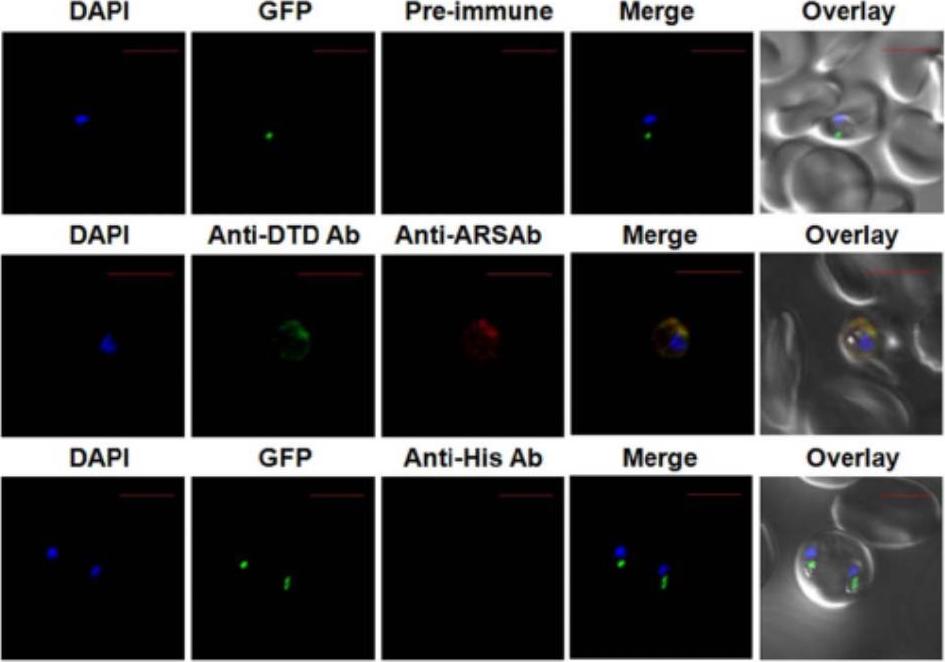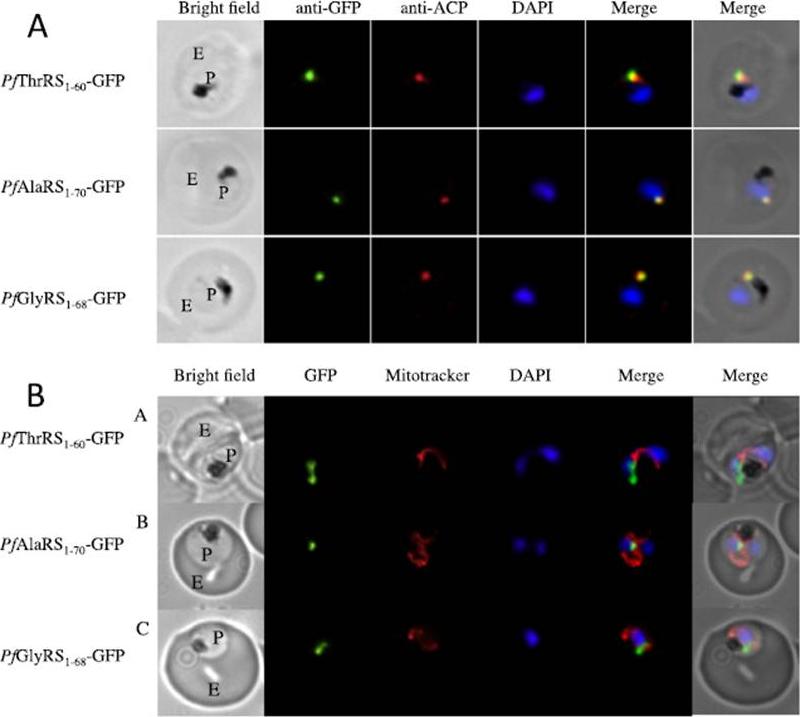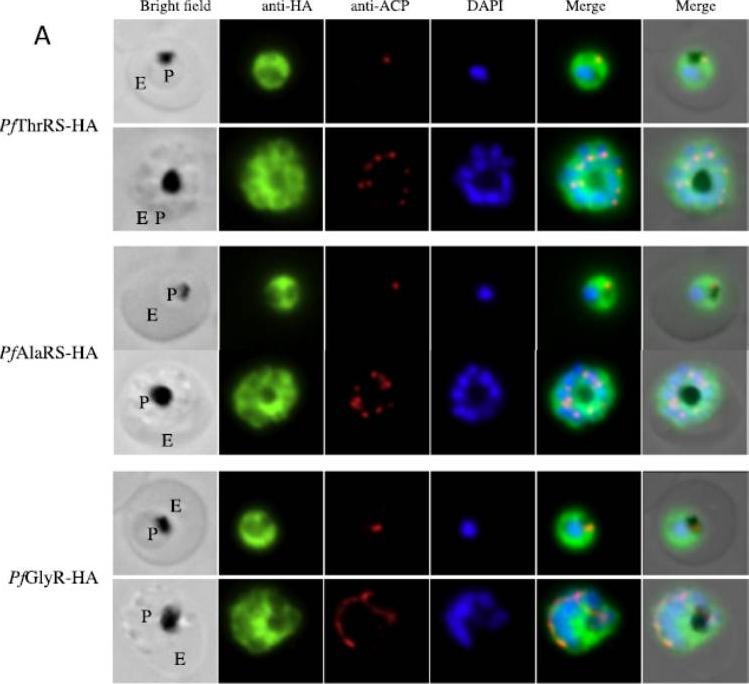PBANKA_1143600 alanine--tRNA ligase, putative (AlaRS)
Disruptability [+]
| Species | Disruptability | Reference | Submitter | |
|---|---|---|---|---|
| P. berghei ANKA |
Refractory |
PlasmoGEM (Barseq) | PlasmoGEM | |
| P. falciparum 3D7 |
Refractory |
USF piggyBac screen (Insert. mut.) | USF PiggyBac Screen | |
Mutant phenotypes [+]
None reported yet. Please press the '+' button above to add one.Imaging data (from Malaria Metabolic Pathways)

Expression and localization of tRNAAla synthetase (Pf-Ed-ARS). Displays cellular localizations. Upper and lower panels show confocal IFA with pre-immune sera and with anti-histidine antibodies, whereas the middle panel depicts cytoplasmic staining of Pf-DTD. Data clearly show in the parasite apicoplast as well as in the cytoplasm. The parasite line used was GFP-tagged (strain D10 ACPleader-GFP) where apicoplast fluoresces green. DAPI staining is in blue while aminoacyl-tRNA synthetases are stained with Alexa594 (red).Khan S, Sharma A, Jamwal A, Sharma V, Pole AK, Thakur KK, Sharma A. Uneven spread of cis- and trans-editing aminoacyl-tRNA synthetase domains within translational compartments of P. falciparum. Sci Rep. 2011;1:188.
See original on MMP
The N-terminus of Plasmodium falciparum (Pf)ThrRS, PfGlyRS and PfAlaRS directs apicoplast targeting. (A) PfThrRS1–60-GFP, PfAlaRS1–70-GFP and PfGlyRS1–68-GFP transfected parasites were labelled with anti-GFP and anti-acyl carrier protein antibodies and DAPI. The aminoacyl-tRNA synthetase–GFP fusions overlap with the apicoplast marker ACP, demonstrating that the N-terminus of these gene products is sufficient for apicoplast targeting. Bright field panels show the parasite (P) residing in its host erythrocyte (E). (B) Live cell microscopy shows that the N-terminal fragments of the nuclear encoded organellar tRNAs (aaRS) do not direct trafficking to mitochondria. Live parasites were stained using Mitotracker to highlight the mitochondria and this was compared with the GFP signal for each of the aaRS–GFP parasites. In all cases the mitochondria labelled a distinct and separate organelle from the GFP, indicating that these N-terminal leaders do not direct mitochondrial trafficking.Jackson KE, Pham JS, Kwek M, De Silva NS, Allen SM, Goodman CD, McFadden GI, Ribas de Pouplana L, Ralph SA. Dual targeting of aminoacyl-tRNA synthetases to the apicoplast and cytosol in Plasmodium falciparum. Int J Parasitol. 2012 42:177-86. PMID:
See original on MMP
Epitope-tagging of Plasmodium falciparum tRNAThr, tRNAGly and tRNAAla. The single, chromosomal copies of PfThrRS, PfGlyRS and PfAlaRS were tagged with a triple hemagglutinin through transfection and 3’ replacement. Immunfluorescence assays show that the majority of each of these epitope tagged proteins is localized to the parasite cytosol. An early trophozoite and a schizont stage parasite are shown for each parasite line. Parasites were labelled with anti-HA and anti-acyl carrier protein antibodies and DAPI. Bright field panels show the parasite (P) residing in its host erythrocyte (E). Some epitope tagged protein colocalises with the apicoplast marker ACP, but the dominant signal from the cytosolic HA-tagged protein in these parasites makes it unclear whether this is specific colocalisation or signal from adjacent protein. The very small size of the apicoplast (~200 nm diameter) makes this question difficult to resolve by light microscopy under these conditions. Jackson KE, Pham JS, Kwek M, De Silva NS, Allen SM, Goodman CD, McFadden GI, Ribas de Pouplana L, Ralph SA. Dual targeting of aminoacyl-tRNA synthetases to the apicoplast and cytosol in Plasmodium falciparum. Int J Parasitol. 2012 42:177-86.
See original on MMPMore information
| PlasmoDB | PBANKA_1143600 |
| GeneDB | PBANKA_1143600 |
| Malaria Metabolic Pathways | Localisation images Pathways mapped to |
| Previous ID(s) | PB001101.00.0, PBANKA_114360 |
| Orthologs | PCHAS_1143100 , PF3D7_1367700 , PKNH_1103500 , PVP01_1104300 , PVX_115345 , PY17X_1144900 |
| Google Scholar | Search for all mentions of this gene |